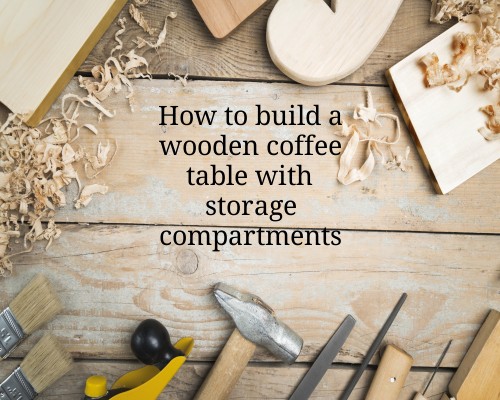Building a wooden coffee table with storage compartments is a rewarding project that combines functionality with craftsmanship. Here’s a step-by-step guide on how to create your own:
Materials Needed:
- Wood (choose hardwood like oak, maple, or plywood for durability)
- Wood screws
- Wood glue
- Sandpaper (120 and 220 grit)
- Wood stain or paint (optional)
- Varnish or polyurethane finish
- Hinges (if you plan to make a lid that opens)
- Handles or knobs (optional)
- Measuring tape
- Saw (circular saw, table saw, or miter saw)
- Drill with bits
- Clamps
Step 1: Plan and Measure
Before you begin, plan out the dimensions and style of the coffee table. Decide on the size of the table (length, width, and height) and how many storage compartments you want. For example, a common coffee table size is 48 inches long, 24 inches wide, and 18 inches high. For storage compartments, consider dividing the space into two or three equal sections, or customize it to fit your needs.
Sketch a basic design with all dimensions marked, including the height and depth of the compartments. If you plan on adding a lift-up top or sliding doors, incorporate that into your design as well.
Step 2: Cut the Wood
Cut the wood according to your measurements:
- Tabletop: One piece, typically a rectangle.
- Side panels: Four pieces for the sides of the table.
- Bottom panel: One piece for the bottom of the table.
- Storage compartment dividers: If you want separate storage sections, cut the dividers from the same material used for the side panels.
Use a table saw or circular saw to make straight cuts. For smooth edges, sand them lightly after cutting.
Step 3: Assemble the Frame
- Attach the side panels to the bottom panel. Begin by applying wood glue to the edges of the bottom panel where the side panels will attach. Use wood screws for extra stability, pre-drilling holes to avoid splitting the wood.
- Install the dividers for the storage compartments, ensuring they are centered and aligned correctly. Use wood glue and screws to fix them securely.
If you are creating a storage compartment with a lid, install the hinges on the top of the table’s side panels so the lid can open easily.
Step 4: Install the Tabletop
- Apply wood glue along the top edges of the frame.
- Carefully place the tabletop on top and secure it with screws. You may want to countersink the screws so they are not visible, or use wood plugs to hide them.
If your design includes a lift-up top, use hinges on the back edge of the tabletop. If the top is meant to slide, add sliding rails on the sides for smooth movement.
Step 5: Sand the Table
Once your coffee table frame is assembled, begin sanding the entire piece with a 120-grit sandpaper to remove any rough spots or excess glue. Finish with a finer 220-grit sandpaper for a smoother surface. Sand in the direction of the wood grain to achieve a better finish.
Step 6: Finish the Wood
Now, you can add a wood stain, paint, or simply varnish the table to protect it and enhance its appearance.
- Stain: Apply wood stain with a clean cloth, following the wood grain. Allow it to dry completely before applying a second coat or finishing with a topcoat.
- Paint: If you prefer a painted finish, use a high-quality paint designed for wood. Consider applying a primer first, especially if you’re using a lighter color.
- Polyurethane: After staining or painting, apply several coats of polyurethane to protect the table and give it a smooth, durable finish.
Allow each coat to dry before applying the next.
Step 7: Add Handles or Knobs (Optional)
If your table has storage compartments that you want to open, you can add handles or knobs to the front panels. Drill holes in the front of the table, then screw in the hardware.
Step 8: Final Assembly and Touch-ups
Once the finish is completely dry, inspect your table for any imperfections and do touch-ups if needed. Re-tighten any screws or add additional support if necessary. Finally, place your table where you’d like it in your home and organize your storage compartments.
By following these steps, you will have a beautiful, functional wooden coffee table with storage compartments. This piece can serve as both a focal point in your living room and a practical storage solution for books, magazines, remote controls, or other household items.
If you’re looking for additional woodworking projects or need step-by-step guidance, consider checking out Ted’s Woodworking Course for more detailed plans and expert tips! Explore Ted’s Woodworking Course here.
